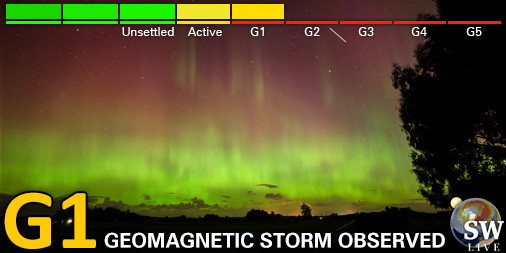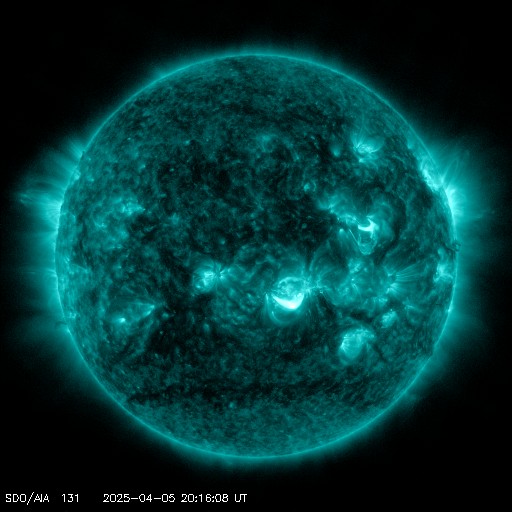Viewing archive of Thursday, 12 May 2005
Geophysical report
Joint USAF/NOAA Solar and Geophysical Activity Summary
SGAS Number 132 Issued at 0245Z on 12 May 2005 This report is compiled from data received at SWO on 11 MayA. Energetic Events
Begin Max End Rgn Loc Xray Op 245MHz 10cm Sweep 0503 0523 0536 0758 S11W30 M1.3 Sf 260 IV 0611 0641 0656 0758 M1.2 160 1922 1938 1955 0758 S10W47 M1.1 1f 1937 1937 1937 51 II
B. Proton Events
C. Geomagnetic Activity Summary
D. Stratwarm
E. Daily Indices: (real-time preliminary/estimated values)
10 cm 125 SSN 117 Afr/Ap 006/011 X-ray Background B4.4 Daily Proton Fluence (flux accumulation over 24 hrs) GT 1 MeV 7.8e+05 GT 10 MeV 1.5e+04 p/(cm2-ster-day) (GOES-11 satellite synchronous orbit W114 degrees) Daily Electron Fluence GT 2 MeV 7.30e+07 e/(cm2-ster-day) (GOES-12 satellite synchronous orbit W76 degrees) 3 Hour K-indices Boulder 1 0 2 1 2 2 3 3 Planetary 1 0 2 3 2 3 3 4
F. Comments
None
All times in UTC
Current data suggests there is a moderate possibility for aurora to appear at the following high latitude regions in the near future
Gillam, MBCurrent data suggests there is a slight possibility for aurora to appear at the following high latitude regions in the near future
Iqaluit, NUNuuk
Tórshavn
Reykjavik
Latest news
Latest forum messages
Support SpaceWeatherLive.com!
A lot of people come to SpaceWeatherLive to follow the Sun's activity or if there is aurora to be seen, but with more traffic comes higher server costs. Consider a donation if you enjoy SpaceWeatherLive so we can keep the website online!

Latest alerts
02:00 UTC - Geomagnetic activity
Minor G1 geomagnetic storm (Kp5) Threshold Reached: 01:50 UTC
Saturday, 5 April 2025
20:30 UTC - Geomagnetic activity
Minor G1 geomagnetic storm (Kp5) Threshold Reached: 20:20 UTC
20:24 UTC - Solar flare
Moderate M1.05 flare
20:09 UTC - Radio Blackout
Minor R1 radio blackout in progress (≥M1 - current: M1.05)
10:00 UTC - Hemispheric Power Index
The OVATION model predicts the Hemispheric Power Index to reach 78GW at 10:32 UTC
Space weather facts
| Last X-flare | 2025/03/28 | X1.1 |
| Last M-flare | 2025/04/05 | M1.0 |
| Last geomagnetic storm | 2025/04/04 | Kp5+ (G1) |
| Spotless days | |
|---|---|
| Last spotless day | 2022/06/08 |
| Monthly mean Sunspot Number | |
|---|---|
| March 2025 | 134.2 -20.4 |
| April 2025 | 148 +13.8 |
| Last 30 days | 130.7 -14.4 |





